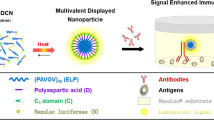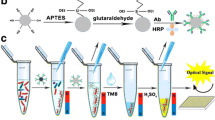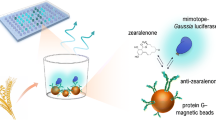Abstract
Chemical modification of the enzymes with biospecific macromolecules is used in various fields of biotechnology to impart new functions or improve their properties and is a fast and convenient way to get the final products. The preparation of highly active, stable, and functionally active conjugates of the thermostable luciferase through the NH2-groups or free SH-groups of the enzyme with target molecules of different molecular weight (albumin, avidin from chicken eggs, antibodies, and progesterone) is described. The obtained conjugates were successfully tested as a reporter in bioluminescent immunoassay for the detection of the molecules and pathogens. Thus, the luc-albumin (Luc-Alb) and luc-insulin (Luc-Ins) conjugates were used in competitive ELISA for the detection of an analyte (albumin or insulin) in the samples. Luc-progesterone (Luc-Pg) was used in the rapid homogeneous immunoassay of progesterone by the BRET technique with the detection limit of 0.5 ng/ml. Luciferase conjugates with avidin (Luc-Avi) and secondary and primary antibodies (Luc-RAM and Luc-Sal) were used for enzyme immunoassay detection of Salmonella paratyphi A cells with the cell detection limit of 5 × 104 CFU/ml. To reduce the detection limit of Salmonella cells, we developed a pseudo-homogeneous bioluminescent enzyme immunoassay of cells using a new matrix for the analyte capture—polystyrene microparticles coated with Pluronic F108, covalently labeled with Sal antibodies. This allowed to achieve efficient trapping of cells from solution, significantly reduced nonspecific sorption and decreased the cell detection limit to 2.7 × 103 CFU/ml without prior concentration of the sample. The methodology that was developed in this study can be applied for the development of novel bioanalytical systems based on firefly luciferases.



Similar content being viewed by others
Data Availability
Informed consent was obtained from all authors of the manuscript.
References
Bavisetty SCB, Vu HTK, Benjakul S, Vongkamjan K (2018) Rapid pathogen detection tools in seafood safety. Curr Opin Food Sci 20:92–99. https://doi.org/10.1016/j.cofs.2018.05.013
Chin NA, Salihah NT, Ahmed SP, MU, (2022) Recent trends and developments of PCR-based methods for the detection of food-borne Salmonella bacteria and norovirus. J Food Sci Technol 59:4570–4582. https://doi.org/10.1007/s13197-021-05280-5
Devine JH, Kutuzova GD, Green VA, Ugarova NN, Baldwin TO (1993) Luciferase from the east European firefly Luciola mingrelica: cloning and nucleotide sequence of the cDNA, overexpression in Escherichia coli and purification of the enzyme. Biochim Biophys Acta 1173(2):121–132. https://doi.org/10.1016/0167-4781(93)90172-a
Erikaku T, Zenno S, Inouye S (1991) Bioluminescent immunoassay using a monomeric Fab-photoprotein aequorin conjugate. Biochem Biophys Res Commun 174:1331–1336. https://doi.org/10.1016/0006-291x(91)91568-w
Frank LA (2010) Ca2+-regulated photoproteins: effective immunoassay reporters. Sensors (basel) 10(12):11287–11300. https://doi.org/10.3390/s101211287
Frank LA, Illarionova VA, Vysotski ES (1996) Use of proZZ-obelin fusion protein in bioluminescent immunoassay. Biochem Biophysical Res Commun 219:475–479. https://doi.org/10.1006/bbrc.1996.0258
Frank LA, Petunin AI, Vysotski ES (2004) Bioluminescent immunoassay of thyrotropin and thyroxine using obelin as a label. Anal Biochem 325:240–246. https://doi.org/10.1016/j.ab.2003.11.003
Fry AK, Schilke KF, McGuireJ BKE (2010) Synthesis and anticoagulant activity of heparin immobilized “end-on” to polystyrene microspheres coated with end-group activated polyethylene oxide. J Biomed Mater Res B Appl Biomater 94(1):187–195. https://doi.org/10.1002/jbm.b.31640
Fukuda S, Tatsumi H, Igarashi H, Igimi S (2000) Rapid detection of Staphylococcus aureus using bioluminescent enzyme immunoassay. Lett Appl Microbiol 31(2):134–138. https://doi.org/10.1046/j.1365-2672.2000.00779.x
Fukuda S, Igimi TH, S, Yamamoto S, (2005) Improved bioluminescent enzyme immunoassay for the rapid detection of Salmonella in chicken meat samples. Lett Appl Microbiol 41(5):379–384. https://doi.org/10.1111/j.1472-765X.2005.01783.x
Haljasmägi L, Remm A, Rumm AP, Krassohhina E, Sein H, Tamm A (2020) LIPS method for the detection of SARS-CoV-2 antibodies to spike and nucleocapsid proteins. Eur J Immunol 50:1234–1236. https://doi.org/10.1002/eji.202048715
Jasson V, Jacxsens L, Luning P, Rajkovic A, Uyttendaele M (2010) Alternative microbial methods: an overview and selection criteria. Food Microbiol 27(6):710–730. https://doi.org/10.1016/j.fm.2010.04.008
Jayachandran B, Parvin TN, Alam MM, Chanda K, Mm B (2022) Insights on chemical crosslinking strategies for proteins. Molecules 27:8124. https://doi.org/10.3390/molecules27238124
Kobatake et al (1993) Kobatake E, Iwai T, Ikariyama Y., Aizawa M (1993) Bioluminescent immunoassay with a protein A-luciferase fusion protein. Anal Biochem 208:300–305. https://doi.org/10.1006/abio.1993.1050
Koksharov MI, Ugarova NN (2011) Thermostabilization of firefly luciferase by in vivo directed evolution. Protein Eng Des Sel 24(11):835–844. https://doi.org/10.1093/protein/gzr044
Kricka LJ (1991) Chemiluminescent and bioluminescent techniques. Clin Chem 37(9):1472–1481
Lee K-M, Runyon M, Herrman TJ, Phillips R, Hsieh J (2015) Review of Salmonella detection and identification methods: aspects of rapid emergency response and food safety. Food Control 47:264–276. https://doi.org/10.1016/j.foodcont.2014.07.011
Lindbladh C, Mosbach K, Bülow L (1991) Preparation of a genetically fused protein A/luciferase conjugate for use in bioluminescent immunoassays. J Immunological Methods 137:199–207. https://doi.org/10.1016/0022-1759(91)90025-b
Lomakina GY, Ugarova NN (2012) Conjugation of Luciola mingrelica firefly luciferase with biospecific proteins through the enzyme SH-groups. Luminescence 27(2):134–135. https://doi.org/10.1002/bio.2341
Lomakina GY, Ugarova NN (2022) Bioluminescent test systems based on firefly luciferase for studying stress effects on living cells. Biophys Rev 14:887–892. https://doi.org/10.1007/s12551-022-00978-y
Lomakina GY, Modestova YA, Ugarova NN (2008) Enhancement of thermostability of the Luciola mingrelica firefly luciferase by site-directed mutagenesis of nonconservative cysteine residues cys62 and cys146. Moscow Univ Chem Bull 63(2):63–66. https://doi.org/10.1134/S0006297911100087
Lomakina GY, Istrate A, Rudenko NV, Ugarova NN (2014) Synthesis and application of firefly luciferase antibody conjugates in a bioluminescent immunoassay of Salmonella cells. Moscow Univ Chem Bull 69:49–55. https://doi.org/10.3103/S0027131414020047
Lomakina GY, Modestova YA, Ugarova NN (2015) Bioluminescence Assay for Cell Viability Biochemistry (mosc) 80(6):701–713. https://doi.org/10.1134/S0006297915060061
Maeda M (2003) New label enzymes for bioluminescent enzyme immunoassay. J Pharm Biomed Anal 30(6):1725–1734. https://doi.org/10.1016/s0731-7085(02)00514-9
Mandal PK, Biswas AK, Choi K, Pal UK (2011) Methods for rapid detection of foodborne pathogens: an overview. Am J Food Technol 6:87–102. https://doi.org/10.3923/ajft.2011.87.1022
Merkulova TI, Abbasova SG, Moshnikova AB (1995) Monoclonal antibodies directed against unique and common determinants on the lipopolysaccharide molecule of Salmonella serogroups A, B, and D. Hybridoma 14(6):557–562. https://doi.org/10.1089/hyb.1995.14.557
Mirhosseini SA, Fooladi AAI, Amani J, Sedighian H (2017) Production of recombinant flagellin to develop ELISA-based detection of Salmonella enteritidis. Braz J Microbiol 48(4):774–781. https://doi.org/10.1016/j.bjm.2016.04.033
Modestova YA, Lomakina GY, Ugarova NN (2011) Site-directed mutagenesis of cysteine residues of Luciola mingrelica firefly luciferase. Biochemistry (mosc) 76(10):1147–1154. https://doi.org/10.1134/S0006297911100087
Murphy MJ, Squirrell DJ (1994) Covalent coupling of firefly luciferase to antibodies. In: Campbell AK, Kricka LJ, Stanley PE (eds) Bioluminescence and Chemiluminescence: Fundamental and applied aspects. John Wiley and Sons, Chichester, pp 301–304
Oyama H, Kiguchi Y, Morita I, Miyashita T, Ichimura A, Miyaoka H, Izumi A, Terasawa S, Osumi N, Tanaka H, Niwa T, Kobayashi N (2021) NanoLuc luciferase as a suitable fusion partner of recombinant antibody fragments for developing sensitive luminescent immunoassays. Anal Chim Acta 1161:238180. https://doi.org/10.1016/j.aca.2020.12.055
Park MK (2023) Comparison of gold biosensor combined with light microscope imaging system with ELISA for detecting Salmonella in chicken after exposure to simulated chilling condition. J Microbiol Biotechnol 33(2):228–234. https://doi.org/10.4014/jmb.2212.12011
Ren W, Li Z, Xu Y, Wan D, Barnych B, Li Y, Tu Z, He Q, Fu J, Hammock BD (2019) One-step ultrasensitive bioluminescent enzyme immunoassay based on nanobody/nanoluciferase fusion for detection of aflatoxin B1 in cereal. J Agric Food Chem 67:5221–5229. https://doi.org/10.1021/acs.jafc.9b00688
Ren Y, Wei J, Wang Y, Wang P, Ji Y, Liu B, Wang J, González-Sapienza G, Wang Y (2022) Development of a streptavidin-bridged enhanced sandwich ELISA based on self-paired nanobodies for monitoring multiplex Salmonella serogroups. Anal Chim Acta 1203:339705. https://doi.org/10.1016/j.aca.2022.339705
Sibley CD, Peirano G, Church DL (2012) Molecular methods for pathogen and microbial community detection and characterization: current and potential application in diagnostic microbiology. Infect Genet Evol 12(3):505–521. https://doi.org/10.1016/j.meegid.2012.01.011
Smirnova DV, Samsonova JV, Ugarova NN (2016) The bioluminescence resonance energy transfer from firefly luciferase to a synthetic dye and its application for the rapid homogeneous immunoassay of progesterone. Photochem Photobiol 92(1):158–165. https://doi.org/10.1111/php.12556
Tatsumi H, Fukuda S, Kikuchi M, Koyama Y (1996) Construction of biotinylated firefly luciferases using biotin acceptor peptides. Anal Biochem 243:176–180. https://doi.org/10.1006/abio.1996.0498
Valdivieso-Garcia A, Desruisseau A, Riche E, Fukuda S, Tatsumi H (2003) Evaluation of a 24-hour bioluminescent enzyme immunoassay for the rapid detection of Salmonella in chicken carcass rinses. J Food Prot 66(11):1996–2004. https://doi.org/10.4315/0362-028X-66.11.1996
Viviani VR, Silva JR, Ho PL (2021) A novel brighter bioluminescent fusion protein based on ZZ domain and Amydetes vivianii firefly luciferase for immunoassays. Front Bioeng Biotechnol 9:755045. https://doi.org/10.3389/fbioe.2021.755045
Funding
This work was performed as part of the state registration topic of Lomonosov Moscow State University, no. 121041500039–8.
Author information
Authors and Affiliations
Corresponding author
Ethics declarations
Ethical approval
Not applicable.
Consent to participate
Not applicable.
Conflict of interest
The authors declare no competing interests.
Additional information
Publisher's note
Springer Nature remains neutral with regard to jurisdictional claims in published maps and institutional affiliations.
Rights and permissions
Springer Nature or its licensor (e.g. a society or other partner) holds exclusive rights to this article under a publishing agreement with the author(s) or other rightsholder(s); author self-archiving of the accepted manuscript version of this article is solely governed by the terms of such publishing agreement and applicable law.
About this article
Cite this article
Lomakina, G.Y., Ugarova, N.N. Luciola mingrelica firefly luciferase as a marker in bioluminescent immunoassays. Biophys Rev 15, 955–962 (2023). https://doi.org/10.1007/s12551-023-01115-z
Received:
Accepted:
Published:
Issue Date:
DOI: https://doi.org/10.1007/s12551-023-01115-z




